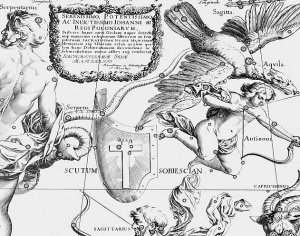Messier 11: Difference between revisions
No edit summary |
No edit summary |
||
| Line 4: | Line 4: | ||
==Science and History== | ==Science and History== | ||
The [[Messier 11]] Wild Duck cluster is an open star cluster like the Pleiades and the Hyades, except that it’s much farther away. The Pleiades and Hyades cluster lie about 430 light-years and 150 light-years away, respectively, whereas the Wild Duck Cluster resides some 5,500 light-years distant. It was discovered in 1681 by Gottfried Kirch, and was probably first resoved into stars by William Durheim around 1733.At first glance, the Wild Duck Cluster looks like a globular cluster, like M13 and M5. M11 is one of the richest and most compact of open star clusters, composed of a few thousand hot, young stars that are only a few million years old. Globular clusters, on the other hand, contain tens to hundreds of thousands of stars that are billions of years old.The 19th century observer Admiral Smyth thought the distinctive wedge-shape group of stars in M11 resembled a flock of wild ducks flying by, hence the nickname Wild Duck Cluster. The luminosity of many of M11’s stars exceeds that of the sun by a hundredfold. If we lived on a planet within this star cluster, we’d see hundreds of first-magnitude stars filling the nighttime, with many of these stars outshining Sirius, the brightest star to shine in Earth’s night sky.The M11 Wild Duck Cluster is positioned at RA: 18h 51m 6s; Dec: 6 degrees 16′ south.<ref>[http://earthsky.org/clusters-nebulae-galaxies/wild-duck-cluster-deep-sky-gem-by-eagles-tail Earthsky]</ref> | The [[Messier 11]] Wild Duck cluster is an open star cluster like the Pleiades and the Hyades, except that it’s much farther away. The Pleiades and Hyades cluster lie about 430 light-years and 150 light-years away, respectively, whereas the Wild Duck Cluster resides some 5,500 light-years distant. It was discovered in 1681 by Gottfried Kirch, and was probably first resoved into stars by William Durheim around 1733.At first glance, the Wild Duck Cluster looks like a globular cluster, like M13 and M5. M11 is one of the richest and most compact of open star clusters, composed of a few thousand hot, young stars that are only a few million years old. Globular clusters, on the other hand, contain tens to hundreds of thousands of stars that are billions of years old.The 19th century observer Admiral Smyth thought the distinctive wedge-shape group of stars in M11 resembled a flock of wild ducks flying by, hence the nickname Wild Duck Cluster. The luminosity of many of M11’s stars exceeds that of the sun by a hundredfold. If we lived on a planet within this star cluster, we’d see hundreds of first-magnitude stars filling the nighttime, with many of these stars outshining Sirius, the brightest star to shine in Earth’s night sky.The M11 Wild Duck Cluster is positioned at RA: 18h 51m 6s; Dec: 6 degrees 16′ south.<ref>[http://earthsky.org/clusters-nebulae-galaxies/wild-duck-cluster-deep-sky-gem-by-eagles-tail Earthsky]</ref> | ||
Revision as of 02:04, 2 March 2015
Messier 11 is The Wild Duck Cluster (also known as Messier 11, or NGC 6705) is an open cluster found in the constellation Scutum the Shield, just south of the Eagle's Tail in the constellation Aquila. It was discovered by Gottfried Kirch in 1681. Charles Messier included it in his catalogue in 1764. The Wild Duck Cluster is one of the richest and most compact of the known open clusters, containing about 2900 stars. Its age has been estimated to about 220 million years. Its name derives from the brighter stars forming a triangle which could resemble a flying flock of ducks. [1]
Science and History
The Messier 11 Wild Duck cluster is an open star cluster like the Pleiades and the Hyades, except that it’s much farther away. The Pleiades and Hyades cluster lie about 430 light-years and 150 light-years away, respectively, whereas the Wild Duck Cluster resides some 5,500 light-years distant. It was discovered in 1681 by Gottfried Kirch, and was probably first resoved into stars by William Durheim around 1733.At first glance, the Wild Duck Cluster looks like a globular cluster, like M13 and M5. M11 is one of the richest and most compact of open star clusters, composed of a few thousand hot, young stars that are only a few million years old. Globular clusters, on the other hand, contain tens to hundreds of thousands of stars that are billions of years old.The 19th century observer Admiral Smyth thought the distinctive wedge-shape group of stars in M11 resembled a flock of wild ducks flying by, hence the nickname Wild Duck Cluster. The luminosity of many of M11’s stars exceeds that of the sun by a hundredfold. If we lived on a planet within this star cluster, we’d see hundreds of first-magnitude stars filling the nighttime, with many of these stars outshining Sirius, the brightest star to shine in Earth’s night sky.The M11 Wild Duck Cluster is positioned at RA: 18h 51m 6s; Dec: 6 degrees 16′ south.[2]
Scutum
Scutum lies in a bright area of the Milky Way and is distinctive despite its small size. Its brightest stars are of only fourth magnitude, and none are named, but the constellation contains a celebrated cluster of stars popularly known as the Wild Duck cluster because its fan-shape resembles a flight of ducks.
In the Chinese constellation system, five or six stars of northern Scutum, including Alpha, Beta and Eta Scuti, were grouped with others in Aquila to form a nine-star constellation called Tianbian. This represented a team of trade officials overseeing the organization and operation of markets. The area of sky to the west, incorporating much of Ophiuchus and Serpens plus southern Hercules, was visualized as a marketplace. [3]
Etymology
Scutum is the Latin word for shield, although it has in modern times come to be specifically associated with the rectangular, semi-cylindrical body shield carried by Roman legionaries. [4]
Session References
HGS Sessions - Parallel Earth 2/12/2015
References
Found in HGS Manual on Page 108




